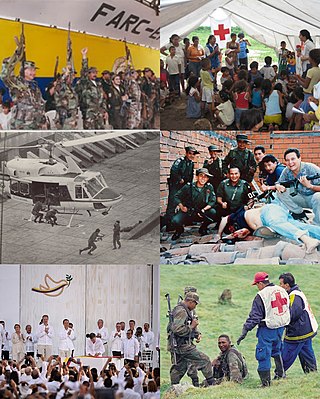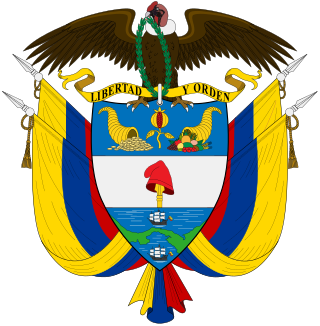Related Research Articles

The Revolutionary Armed Forces of Colombia – People's Army is a Marxist–Leninist guerrilla group involved in the continuing Colombian conflict starting in 1964. The FARC-EP was officially founded in 1966 from peasant self-defense groups formed from 1948 during the "Violencia" as a peasant force promoting a political line of agrarianism and anti-imperialism. They are known to employ a variety of military tactics, in addition to more unconventional methods, including terrorism.

The National Liberation Army is a Marxist–Leninist guerrilla insurgency group involved in the continuing Colombian conflict, which has existed in Colombia since 1964. The ELN advocates a composite communist ideology of Marxism-Leninism and liberation theology. In 2013, it was estimated that the ELN forces consisted of between 1,380 and 3,000 guerrillas. According to former ELN national directorate member Felipe Torres, one fifth of ELN supporters have taken up arms. The ELN has been classified as a terrorist organization by the governments of Colombia, the United States, Canada, New Zealand, and the European Union.

The Colombian conflict began on May 27, 1964, and is a low-intensity asymmetric war between the government of Colombia, far-right paramilitary groups and crime syndicates, and far-left guerrilla groups, fighting each other to increase their influence in Colombian territory. Some of the most important international contributors to the Colombian conflict include multinational corporations, the United States, Cuba, and the drug trafficking industry.

This article covers national and international security issues in Colombia.

This is a timeline of events related to the Colombian conflict.

Colombia–Venezuela relations refers to the diplomatic relations between the South American neighboring countries of Colombia and Venezuela. The relationship has developed since the early 16th century, when Spanish colonizers created the Province of Santa Marta and the Province of New Andalucia. The countries share a history of achieving their independence under Simón Bolívar and becoming one nation—the Gran Colombia—which dissolved in the 19th century. Since then, the overall relationship between the two countries has oscillated between cooperation and bilateral struggle.

The Los Maniceros massacre was the 2009 kidnapping in Colombia of twelve members of a Colombian amateur association football team Los Maniceros, eleven of whom were later murdered. The dead were aged between 17 and 38.

The 2010 Colombia–Venezuela diplomatic crisis was a diplomatic stand-off between Colombia and Venezuela over allegations in July by Colombian President Álvaro Uribe that the Venezuelan government was actively permitting the FARC and ELN guerrillas to seek safe haven in its territory. The Revolutionary Armed Forces of Colombia (FARC), founded in 1964, is the largest of Colombia's left-wing guerilla groups, and the National Liberation Army (ELN), also founded in 1964, is another left-wing guerilla group inspired by the Cuban revolution and Marxist ideology. Uribe presented evidence to the Organization of American States (OAS) and in response, Venezuela broke off diplomatic relations with Colombia amid speculation of a possible war. Both countries eventually reconciled, with the help of the Union of South American nations (UNASUR) and agreed to re-establish diplomatic relations by mid-August.

Los Rastrojos is a Colombian drug cartel and paramilitary group engaged in the Colombian armed conflict. The group was formed by Norte del Valle cartel capo Wilber Varela, alias "Jabon" and one of his right-hand men, "Diego Rastrojo", around 2004 when Varela fell out with fellow-capo Diego Leon Montoya, alias "Don Diego". The group became independent after the murder of its main founder in Venezuela in 2008 and at its height was one of the most important drug trafficking organizations in Colombia.
Terrorism in Colombia has occurred repeatedly during the last several decades, largely due to the ongoing armed conflict the country has been involved in since 1964. Perpetrators of terrorist acts in the country range from leftist guerilla forces including FARC, ELN and M-19, to drug cartels such as the Medellín Cartel, to right-wing paramilitary forces including the AUC.

FARC dissidents, also known as Carlos Patiño Front, are a group, formerly part of the Revolutionary Armed Forces of Colombia (FARC), who have refused to lay down their arms after the Colombian peace process came into effect in 2016, or resumed their insurgency afterwards. In 2018, the dissidents numbered some 2,000, to 2,500, armed combatants with an unknown number of civilian militia supporting them. The FARC dissidents have become "an increasing headache" for the Colombian armed forces, as they have to fight them, the Popular Liberation Army (EPL), the National Liberation Army (ELN), and the Clan del Golfo at the same time.
The 2018 Tumeremo massacre is at least the third civilian massacre of miners in the Venezuelan town of Tumeremo since 2016. Occurring over three days from 14 October 2018, it is suspected that a Colombian guerrilla group is responsible for the murders.
On 17 January 2019, a vehicle was driven into the General Santander National Police Academy in Bogotá, Colombia. The truck forced its way into the facility, hit a wall and detonated, killing 22 people and injuring 68 others. Suicide attacks are unusual in Colombia. The car contained about 80 kilograms (180 lb) of pentolite. It was the deadliest attack on the Colombian capital since the 2003 El Nogal Club bombing and the first terrorist attack on the capital since the 2017 Centro Andino bombing. The National Liberation Army (ELN) accepted responsibility for the attack and justified it as a response to the bombings made by the Colombian government during the unilateral ceasefire.

The Catatumbo campaign has been an ongoing period of strategic violence between militia faction groups in the Catatumbo region of Colombia and Venezuela since January 2018. It is an extension of the War on drugs and developed after the Colombian peace process of 2016. The existence of the war was officially announced in August 2019 after a Human Rights Watch (HRW) investigation. Colombian media reports that the war has directly affected an estimated 145,000 people, with the HRW estimating this at 300,000.

The Pemon conflict is an ongoing conflict which is a part of the wider Crisis in Venezuela. The conflict is centered around mining disputes between the Maduro government, the Pemon nation and armed irregular groups. The Pemon nation is divided by the border between Venezuela and Brazil, resulting in Pemon refugees regularly crossing the border into Brazil for safety and medical care. The conflict is centred on disputes over mining in the Orinoco Mining Arc, a 112,000 km2 area of the Amazon Rainforest rich in gold, diamonds, coltan, and uranium, which are also home to the Pemon people.

The 2021 Apure clashes started on 21 March 2021 in the south of the Páez Municipality, in the Apure state in Venezuela, specifically in La Victoria, a location bordering with Colombia, between guerrilla groups identified as Revolutionary Armed Forces of Colombia (FARC-EP) dissidents and the Venezuelan government led by Nicolás Maduro.
On 2 January 2022, 23 people were killed in clashes between far-left guerrilla groups in Arauca Department, Colombia. The National Liberation Army (ELN) clashed with Revolutionary Armed Forces of Colombia (FARC) dissidents near the border with Venezuela.

Colombia currently has one of the highest populations of internally displaced people (IDPS), at a total amount of over 6.8 million. The majority of IDPS have been displaced due to conflict and violence while others have been displaced due to climate change. Primary contributors to violence include political violence and civil war as well as gang violence. Despite a 2016 peace agreement, political dissident groups have persisted in Colombia, contributing to violence rate similar to those prior to the peace agreement. The Venezuelan refugee crisis has contributed to economic strains and aid requirements in Colombia. Colombia has received aid from organizations like the UNHCR or USAID to help manage humanitarian needs.
The governments of Hugo Chávez and Nicolás Maduro have provided economic, political and military support to the Revolutionary Armed Forces of Colombia (FARC-EP) and the National Liberation Army (ELN). The support of Colombian leftist guerrillas has continued during the government of Nicolás Maduro. By 2018, the investigative group InSight Crime reported that the ELN operated in at least 12 of Venezuela's 23 states. The Venezuelan NGO Fundación Redes (Fundaredes) in 2018 documented more than 250 reports of Venezuelans who were victims of recruitment by Colombian irregular groups. Recruitment has also been denounced by Colombian media.
References
- ↑ "Venezuela blames Colombia after border ambush kills three". France 24. Retrieved 2018-11-05.
- ↑ "Venezuelan defense minister: Border ambush kills 3 soldiers". Washington Post. Archived from the original on 2018-11-06. Retrieved 2018-11-05.